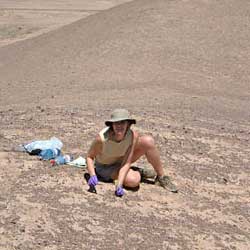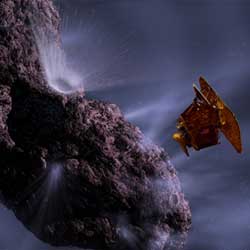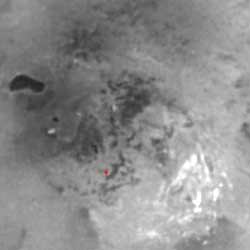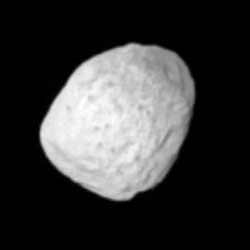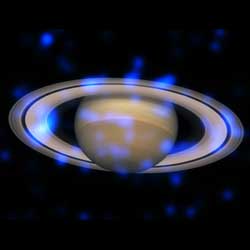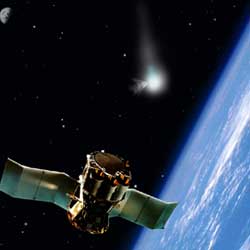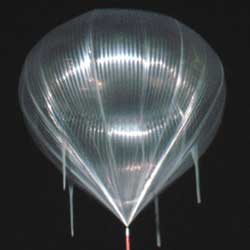
Giant balloon carrying the BLAST instrument into the high atmosphere. Image credit: Joe Martz. Click to enlarge.
Listen to the interview: Having a BLAST in the Arctic (4.5 MB)
Or subscribe to the Podcast: universetoday.com/audio.xml
Fraser Cain: It’s nice to finally have a chance to talk to someone from my home town. How’s the weather there?
Gaelen Marsden: Oh, it’s pretty nice today, nice and sunny.
Fraser: And how does it compare to northern Sweden?
Marsden: Well, it gets dark, which is pretty great.
Fraser: Right, right, 24 hours of sunlight. Can you give me some background on the mission that you just came back from in the North?
Marsden: So, it’s a balloon borne telescope, and carries a 2 metre mirror. BLAST stands for balloon borne large aperture submillimeter telescope. We fly in a balloon to an altitude of 40 kilometres. The 2 metre mirror, which is fairly large for a balloon – it’s nothing compared to ground-based telescopes – but it’s big for a balloon and comparable to current satellite telescopes. We’re measuring in the submillimeter, which is a new frontier. There are a few ground-based telescopes that measure in the submillimeter, but we’re the first ones to do it from near space, not quite space. The advantage to submillimeter is that you’re looking at – in the case of the extragalactic science targets – reprocessed light from very large stars; bright heavy stars as their galaxies first turn on with a flash of star formation. Along with the star formation, you have dust, and the dust absorbs the light from the stars and re-radiates it in the submillimeter. So that’s what we’re looking at.
Fraser: How does a balloon stand as a platform for having an observatory?
Marsden: Right, it’s a quick, cheap, dirty alternative to a satellite. We’re actually piggybacking on the European Space Agency’s called Herschel, which has an experiment on board called SPIRE. We’re using the same detectors and a similar mirror, and they will fly, I believe in 2007; although, it’ll probably be 2008. They’ll do a better job than us. They’re in space, there’s no atmosphere at all, they’ll have much longer observing time, but on the other hand, it costs 100 times as much and takes 10-15 years. Whereas, we put this together in about 5 years. That’s the read advantage; it’s very quick and it’s much cheaper.
Fraser: What other kinds of observations do you think could be done from a balloon-based observatory?
Marsden: Ballooning is nothing new. It’s been going on for probably 30-40 years. One of the most famous ones is the Boomerang telescope, which flew from Antarctica in, I believe, 1998-2000. And that’s CMB, Cosmic Microwave Background studies. There’s been a whole slew of balloon-borne telescopes looking at the Cosmic Microwave Background. And then also it’s very common in atmospheric sciences to use balloons.
Fraser: You launched the balloon a couple of weeks ago from Sweden. Where did it go, and what happened to it?
Marsden: Right, so we launched it Saturday morning. First it goes up, it takes about 3 hours to get to the destination altitude of 38 km, actually we were a little higher than that at first, I think we were closer to just over 39 km. The winds are fairly predictable, these high altitude winds. This is why we do it from Sweden, or from Antarctica. During the summer, the winds go in a circle. Not that we know exactly what it’s going to do, but you know it’s going to go West during the summer. And it did go West. It ended up going quicker than were hoping. The wind models were showing about 20 knots and we were going as fast as 40 knots some of the time. That ended up slowing us down. We were hoping to take 5 days to get across to the Northwest Territories, and it actually ended up being 4 days. And another problem is that we drifted north which caused problems because we wanted to fly all the way across to Alaska, but we ended up being too far north, and we had to cut down to Victoria Island instead, which cut off another 18 hours.
Fraser: So the balloon came around the pole and then drifted over northern Canada. How did you retrieve it?
Marsden: Two members of the team, Mark Devlin and Jeff Klein, both from the University of Pennsylvania, left Sweden after the first day. When the balloon launches, we get line of site telemetry. We get all of the data through a dish. For the first 18 hours or so, we’re getting all of the data. We’re all looking at it carefully, and it’s really important that we get everything set up properly for the rest of the flight to go smoothly. Eventually it passes over the mountains, and we don’t get that high data rate any more, and we get much less – by a factor of like a 1000 or so – data rate. So, for the rest of the flight, we just had a trickle of data coming in. But as soon as the line of sight data was over, Mark and Jeff left Sweden, flew back to Philidelphia, and then quickly left for Northwest Territories, and they were nearby when the balloon came down. It sounds like a fairly difficult task because it was quite remote, and they had to fly in by helicopter. They had to cut the thing up into fairly small pieces to retrieve it all.
Fraser: Now, if I understand correctly, the submillimeter is at the high end of the radio spectrum, and it’s really good for looking at cold objects. So, what exactly were you looking at?
Marsden: From the beginning, the science proposal stated that we had two cases: the extragalactic and also the galactic. Extragalactic was what I was talking about earlier, this high star formation in very young galaxies, and redshifts of up to 3, and possibly 5. That was the extragalactic case. There’s also the galactic case, where we’re looking at planet formation and dust in our own galaxy which is, at this point, not very well known. And it actually turned out that due to the sensitivity of the telescope being lower than we had hoped, we decided that it wasn’t the best use of our time to spend a lot of our time looking at the extragalactic sources. We actually spent most of our time looking at galactic sources because they’re closer, larger, brighter, easier things to see. In the galactic case, I actually myself don’t know a whole lot about the science because I’ve been spending my time studying extragalactic. But we’re looking at cold dust clouds in our own galaxy. Some of them will be forming stars and planets, which at this point is not well known. There are many wavelength observations of all these things, and we’re trying to add the submillimeter portion of it, so that you can look at these sources in the radio, although, I suspect you don’t see them very brightly in radio, but certainly optical. You see these pretty pictures from Hubble of these dusty nebulae, and we’re just adding the submillemeter presence to that curve to see if we can figure out what’s actually going on there.
Fraser: Do you have any more missions planned, or follow up observations?
Marsden: Yeah, definitely. We’re hoping to learn from the things that went wrong here. We had some problems in the flight, certainly we got a lot of science, and we’re very excited about it. There will be a lot of good things coming out of it, but we still want to go after the extragalactic stuff. We’re going to spend the next year or so putting everything back together and then try to get a handle on the things that went wrong with the flight. We’re hoping to turn around for another flight in 18 months from Antarctica.
BLAST Website


